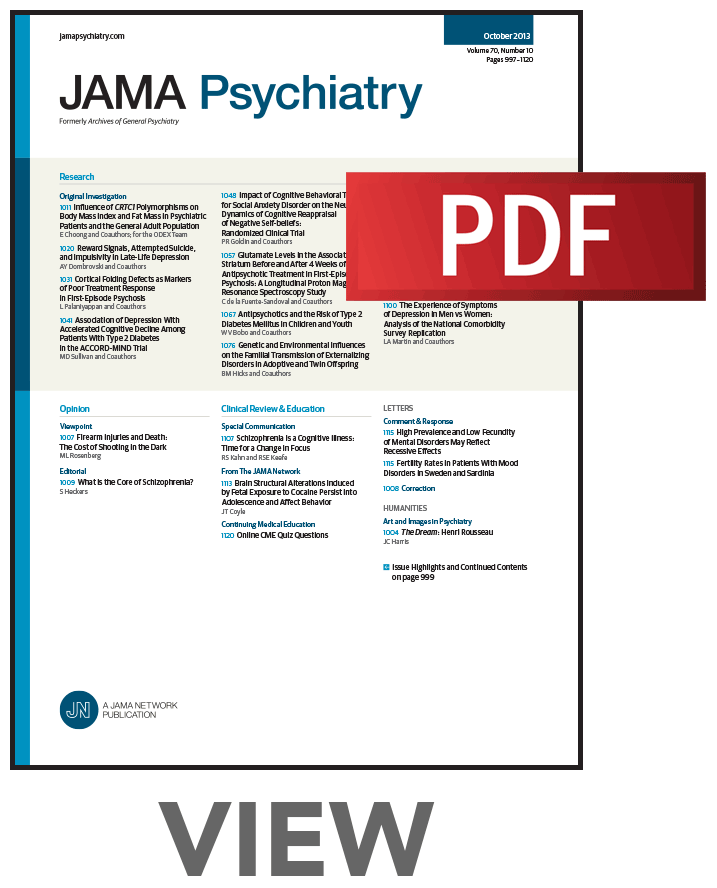自杀意念的两种不同发展途径的心理健康前因及相关因素。
IF 17.1
1区 医学
Q1 PSYCHIATRY
引用次数: 0
摘要
自杀的念头在年轻人中越来越普遍。发展过程中的轨迹和相关的心理健康症状仍然知之甚少。目的描述青少年早期至青年期自杀意念的发展轨迹,识别自杀前和共发的心理健康症状,为最佳预防提供依据。设计、环境和参与者本队列研究使用了一项当代纵向队列研究——曲氏儿童发展纵向研究(QLSCD)的数据,包括参与者、家长和老师的报告。QLSCD是一项以人口为基础的出生队列研究,研究对象是1997年至1998年在加拿大qu忧郁出生的2120名单胞胎,随访至25岁(2023年)。数据分析时间为2024年9月至2025年2月。主要结果和测量方法对13岁、15岁、17岁、20岁、23岁和25岁的参与者进行问卷调查,评估过去12个月的严重自杀意念。心理健康症状(如内化、外化)由父母、老师报告,并在5个发育阶段(学龄前(3-5岁)、儿童期(6-12岁)、青春期早期(13岁)、青春期中后期(15-17岁)和青年期(20-25岁)进行标准化。结果共纳入1635例受试者,其中女性845例,占51.7%;参与者的数量加权,以说明选择性减员)提供的答案自杀意念,与调查权重应用。共确定了3种轨迹:极少/无意识(1433例[87.6%]),青春期早期发病(117例[7.1%]),成年早期发病(86例[5.2%])。相对于很少或没有意识,青春期早期发病与从童年到成年的几乎所有心理健康指标的症状升高有关。这包括内化(如儿童抑郁症状:风险比[RR], 1.75;95% CI, 1.45-2.05)和外化(例如,童年破坏性症状:RR, 1.60;95% CI, 1.29-1.91)症状和母亲反社会症状(RR, 1.39;95% ci, 1.11-1.66)。相反,青年期自杀意念的发作与内化症状相关(例如,青春期中后期抑郁症状:RR, 1.84;95% CI, 1.28-2.39),出现于青春期,并在成年早期加重精神困扰。结论和相关性本队列研究的结果揭示了自杀意念的两种途径:在青春期早期发病,伴有持续的儿童期内化/外化症状;在青年期发病,与青春期出现的内化症状相关,但没有先前的痛苦。研究结果建议及时处理心理健康症状和针对发育阶段的预防。本文章由计算机程序翻译,如有差异,请以英文原文为准。
Mental Health Antecedents and Correlates of 2 Distinct Developmental Pathways to Suicidal Ideation.
Importance
Suicidal ideation is increasingly common in youth. Trajectories and associated mental health symptoms across development remain poorly understood.
Objective
To describe trajectories of suicidal ideation from early adolescence to young adulthood and identify preceding and co-occurring mental health symptoms to inform optimal prevention.
Design, Setting, and Participants
This cohort study used data from a contemporary, longitudinal cohort study, the Québec Longitudinal Study of Child Development (QLSCD), including reports from participants, parents, and teachers. The QLSCD is a population-based birth cohort study of 2120 singletons born between 1997 and 1998 in Québec, Canada, and followed up to age 25 years (2023). Data were analyzed from September 2024 to February 2025.
Main Outcomes and Measures
Serious suicidal ideation in the past 12 months was assessed by a question to participants at ages 13, 15, 17, 20, 23, and 25 years.
Exposures
Mental health symptoms (eg, internalizing, externalizing) as reported by parents, teachers, and self-reports on validated questionnaires and standardized across 5 developmental periods: preschool (3-5 years), childhood (6-12 years), early adolescence (13 years), mid-late adolescence (15-17 years), and young adulthood (20-25 years).
Results
A total of 1635 participants (845 female [51.7%]; participant number is weighted to account for selective attrition) provided answers on suicidal ideation, with survey weights applied. A total of 3 trajectories were identified: minimal/no ideation (1433 [87.6%]), onset in early adolescence (117 [7.1%]), and onset in young adulthood (86 [5.2%]). Relative to minimal/no ideation, onset in early adolescence was associated with elevated symptoms across nearly all mental health indicators from childhood through adulthood. This included both internalizing (eg, childhood depressive symptoms: risk ratio [RR], 1.75; 95% CI, 1.45-2.05) and externalizing (eg, childhood disruptive symptoms: RR, 1.60; 95% CI, 1.29-1.91) symptoms and maternal antisocial symptoms (RR, 1.39; 95% CI, 1.11-1.66). In contrast, onset of suicidal ideation in young adulthood was associated with internalizing symptoms (eg, mid-late adolescence depressive symptoms: RR, 1.84; 95% CI, 1.28-2.39) emerging in adolescence and worsening mental distress in young adulthood.
Conclusions and Relevance
Results of this cohort study revealed 2 pathways to suicidal ideation: onset in early adolescence, with persistent childhood internalizing/externalizing symptoms, and onset in young adulthood linked to internalizing symptoms emerging in adolescence without prior distress. Findings suggest timely addressing of mental health symptoms and developmental stage-specific prevention.
求助全文
通过发布文献求助,成功后即可免费获取论文全文。
去求助
来源期刊

JAMA Psychiatry
PSYCHIATRY-
CiteScore
30.60
自引率
1.90%
发文量
233
期刊介绍:
JAMA Psychiatry is a global, peer-reviewed journal catering to clinicians, scholars, and research scientists in psychiatry, mental health, behavioral science, and related fields. The Archives of Neurology & Psychiatry originated in 1919, splitting into two journals in 1959: Archives of Neurology and Archives of General Psychiatry. In 2013, these evolved into JAMA Neurology and JAMA Psychiatry, respectively. JAMA Psychiatry is affiliated with the JAMA Network, a group of peer-reviewed medical and specialty publications.
 求助内容:
求助内容: 应助结果提醒方式:
应助结果提醒方式:


